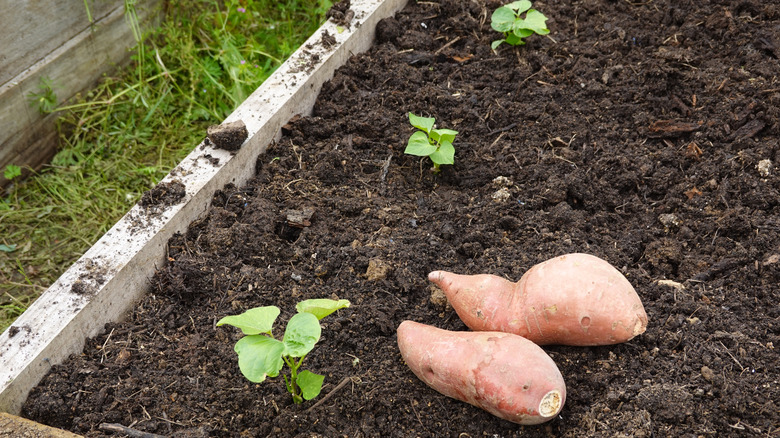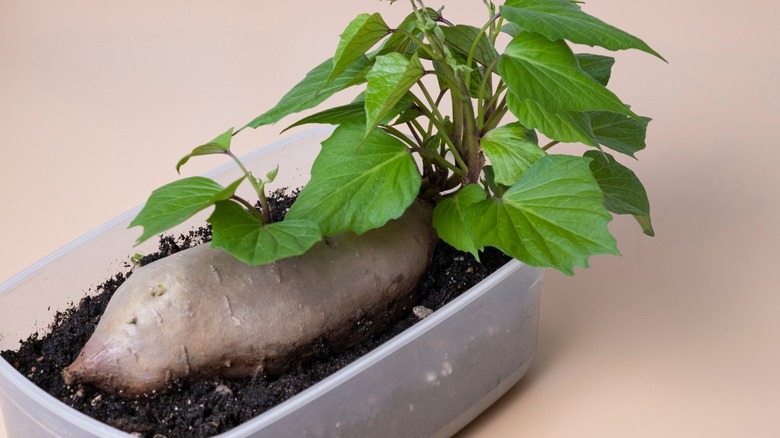Is It Better To Start Sweet Potatoes In Water Or Soil?
Have you ever grown sweet potatoes in your garden beds, a large container, or a grow bag? As these vines need plenty of warmth to produce their favorable tubers, and it can take from 85 to 120 days for the plants to reach maturity, it's common to produce slips (or rooted cuttings) indoors, so they're ready to plant outdoors once temperatures are high enough. This is a good way to regrow sweet potatoes from the grocery store — just make sure you select organic ones. There are two ways that you can start sweet potato slips from a tuber: in water or in soil.
Both methods work equally as well, so whichever you choose depends on your preference. With that being said, starting them in soil might just be a tiny bit easier, and you should be able to create a continuous supply of new slips that will root easily from just a single tuber. Using the soil method can effectively eliminate the extra step of having to root the cuttings in water and give you viable plants much quicker. Ideally, you'll find that February is the right time to start sweet potatoes if you're going to produce slips indoors.
Starting sweet potatoes in water
To start your sweet potatoes in water, all you need is a glass or jar, a couple of toothpicks, and a tuber. Half fill the jar with water and use the toothpicks to suspend the tuber vertically in the glass so that the bottom half (or the pointy end) is submerged. Put this on a sunny windowsill. After a few weeks, you should start to see some roots forming in the water. Make sure you refresh this on a weekly basis so it stays clean. After this, it won't be long before you spot sprouts forming at the top of the tuber. Once these are around 6 to 12 inches long, you can cut or pull them off and then place them in a separate jar of clean water until they produce roots.
The advantages of using this method are two-fold: It's easy, and you can use any receptacle that you have at home. You can continue to leave your tuber in the water, refreshing it weekly, after you've pulled off your first slips, and it will continue to produce new ones. The downsides are that you have to change the water frequently, and it can take around six to eight weeks to produce slips that are ready for planting out. Despite their start in the water, once planted, you'll find that sweet potatoes are one of those popular vegetables that don't need frequent watering to thrive in the garden.
Using soil to start your sweet potatoes
For the soil method, you'll need a shallow container with drainage holes that is long enough to fit the tuber horizontally. Fill this with some potting or seed-raising mix, and insert the tuber vertically so that only half of it is buried in the soil. Put this in a warm spot, such as a sunny windowsill, and keep the mix moist. You should see some sprouts in about two to three weeks. While you can simply twist the slips off and put them in water to grow roots, it's much easier to just slice off a small piece of the tuber that the slip is attached to and place this in a pot filled with potting mix.
The advantage of starting your slips in soil is that you don't have to use the extra step of rooting them in water. If you slice them off with a small section of the tuber, you'll find that these will root quite easily when placed directly in soil. Because of this, this method is a bit quicker than starting the slips in water. You can also leave the remainder of the tuber in the soil and it will continue to produce new slips. The only disadvantage is that you'll end up with slips that are at different stages of growth. If you find that you have young sprouts that won't have enough time to mature in the garden before the weather turns cold, however, the vines also make pretty houseplants.


